Nothing is more exciting than spotting an owl in your backyard if you live in Nevada. These magnificent birds of prey are a beautiful sight to behold. If you’re an avid birdwatcher, you’re probably eager to identify which types of owls are visiting your property.
There are 9 owl species found in Nevada, including the Short-Eared Owl, Long-Eared Owl, Northern Pygmy Owl, Flammulated Owl, Western Screech-Owl, Barn Owl, Great Horned Owl, Burrowing Owl, and Northern Saw-Whet Owl. While several of these owl species have their preferred mating and migratory ranges, it’s possible to spot a vagrant or irrupting owl in areas outside their known territories. If you see an owl in Nevada that is not on this list, consider yourself lucky!
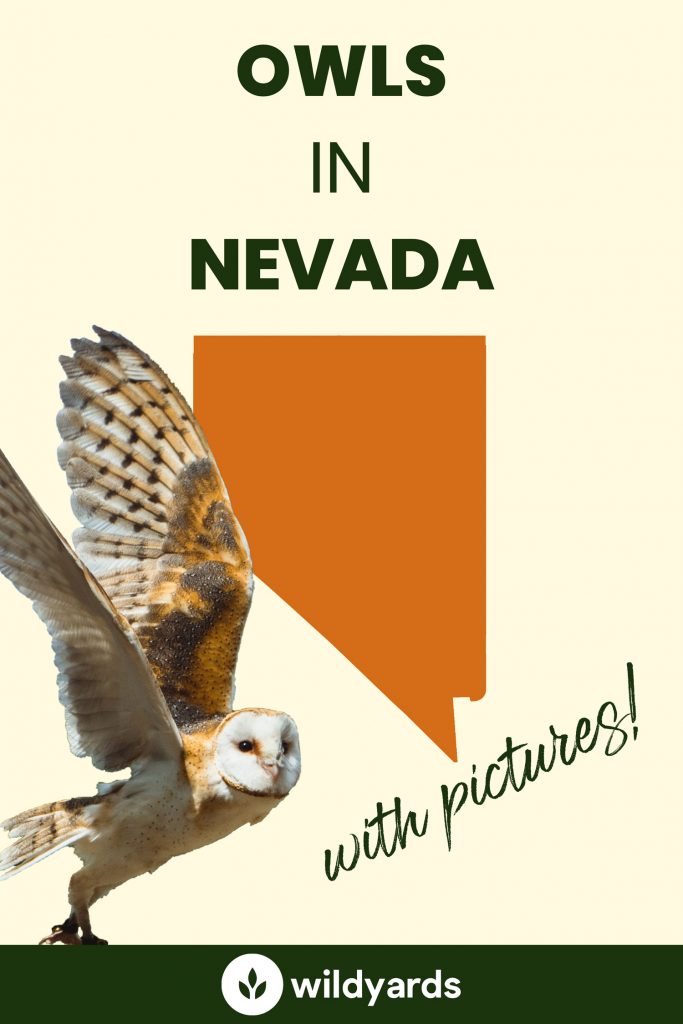
The legend below can be used to help you determine where each of the 9 owls of Nevada lives during different parts of the year.
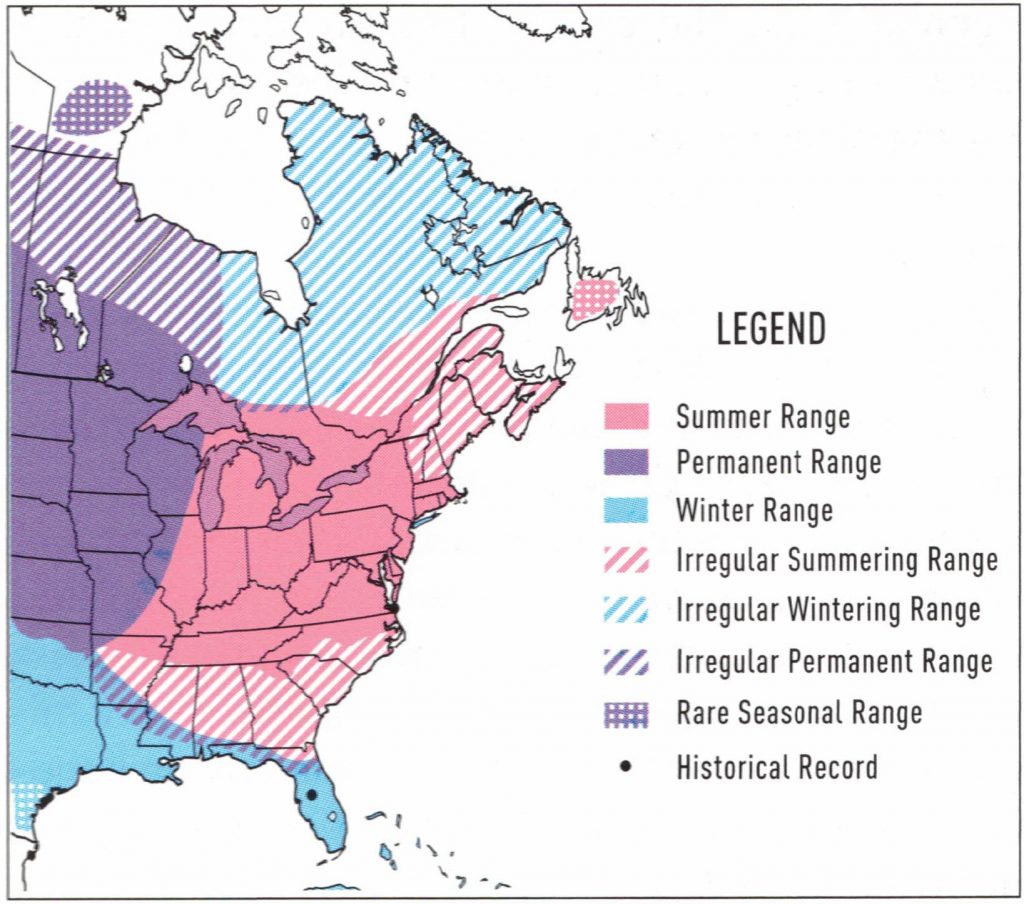
The 9 Species of Owls in Nevada
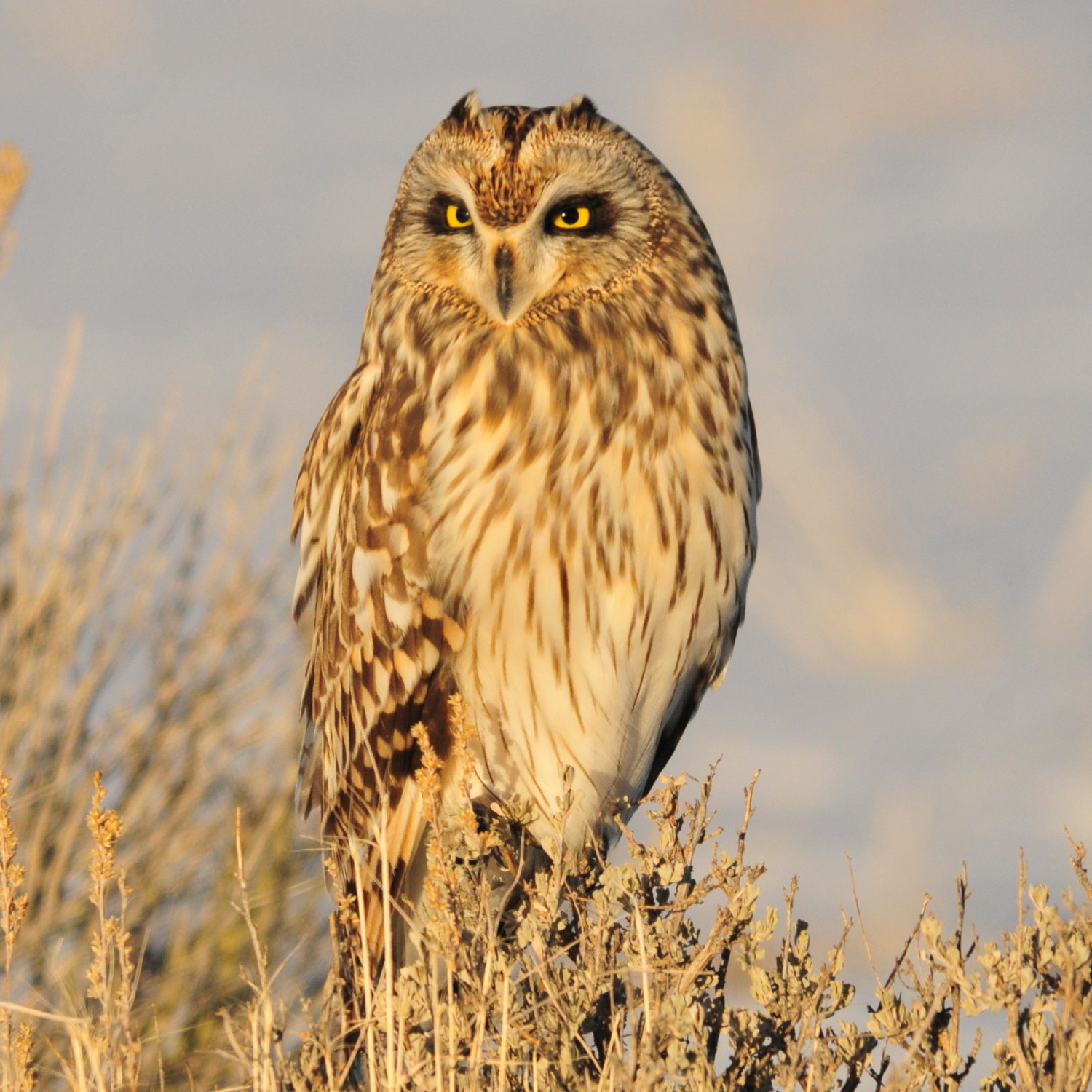
Short-eared Owl
Asio flammeus
Order: Strigiformes
Family: Strigidae
Size: 14.5-15 in. (37-38 cm)
Overview
A classic birdwatcher favorite, short-eared owls hunt during the daytime and can be found throughout the United States. These owls are some of the few that prefer to build their own nests. Females construct their bowl-shaped nests in the ground, lining them with feathers, grasses, and other soft materials before laying clutches of 4 to 7 eggs. Short-eared owls have very distinctive flight patterns, with irregular wingbeats similar to that of bats or moths. These birds are typically 17 inches in length and have wingspans of up to 43 inches. They use their powerful wings to stay upright as they swoop feet-first to capture their prey, which consists of small mammals, rodents, reptiles, and amphibians. Short-eared owls sometimes dine on songbirds and will tear the wings off before swallowing them whole.
How to Identify
The ear tufts of the short-eared owl are situated towards the center of their heads, and they’re so short that sometimes they may not be visible at all. Short-eared owls have tawny plumage on their backs and wings with tan bellies that are interspersed with vertical dark brown streaks. Tailfeathers are barred. These owls have small, round faces with pale tan to creamy white facial disks accented by black-brimmed yellow eyes. Short-eared owls use sharp “waowk-waowk-waowk” calls to communicate and “eeee-yerp” cries during the mating season.
Short-eared Owl Range & Migration Map
Excellent long-distance fliers, short-eared owls have been reported landing on watercraft hundreds of miles from shore. These birds will fly over the ocean and land to reach their breeding grounds in northern Canada. You can find short-eared owls living year-round in the north and northwest portions of the United States. But, because they travel regularly, you can spot stragglers in nearly every state in the nation. These birds prefer to dwell in open areas, including grasslands, marshes, and farmland.
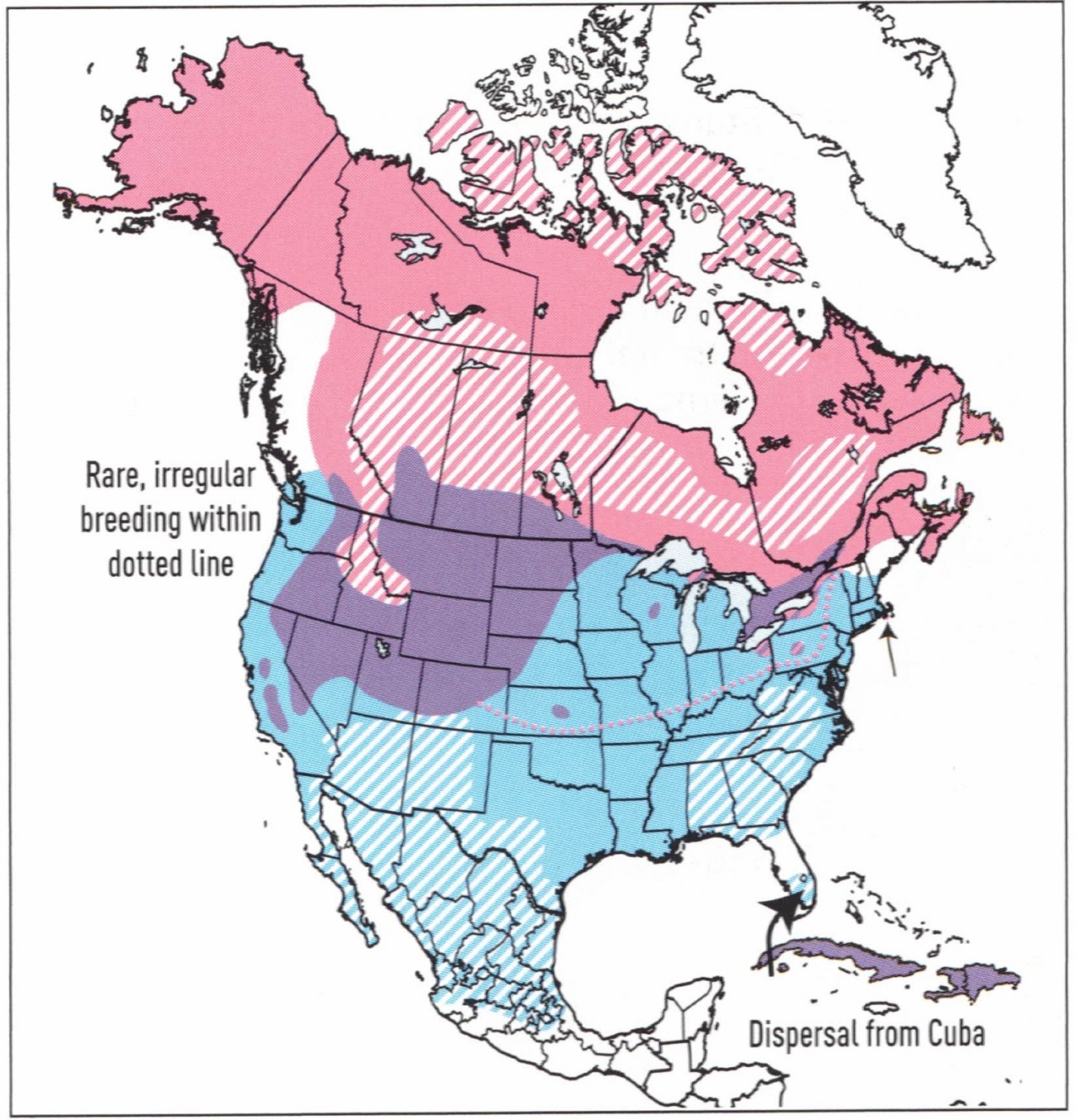
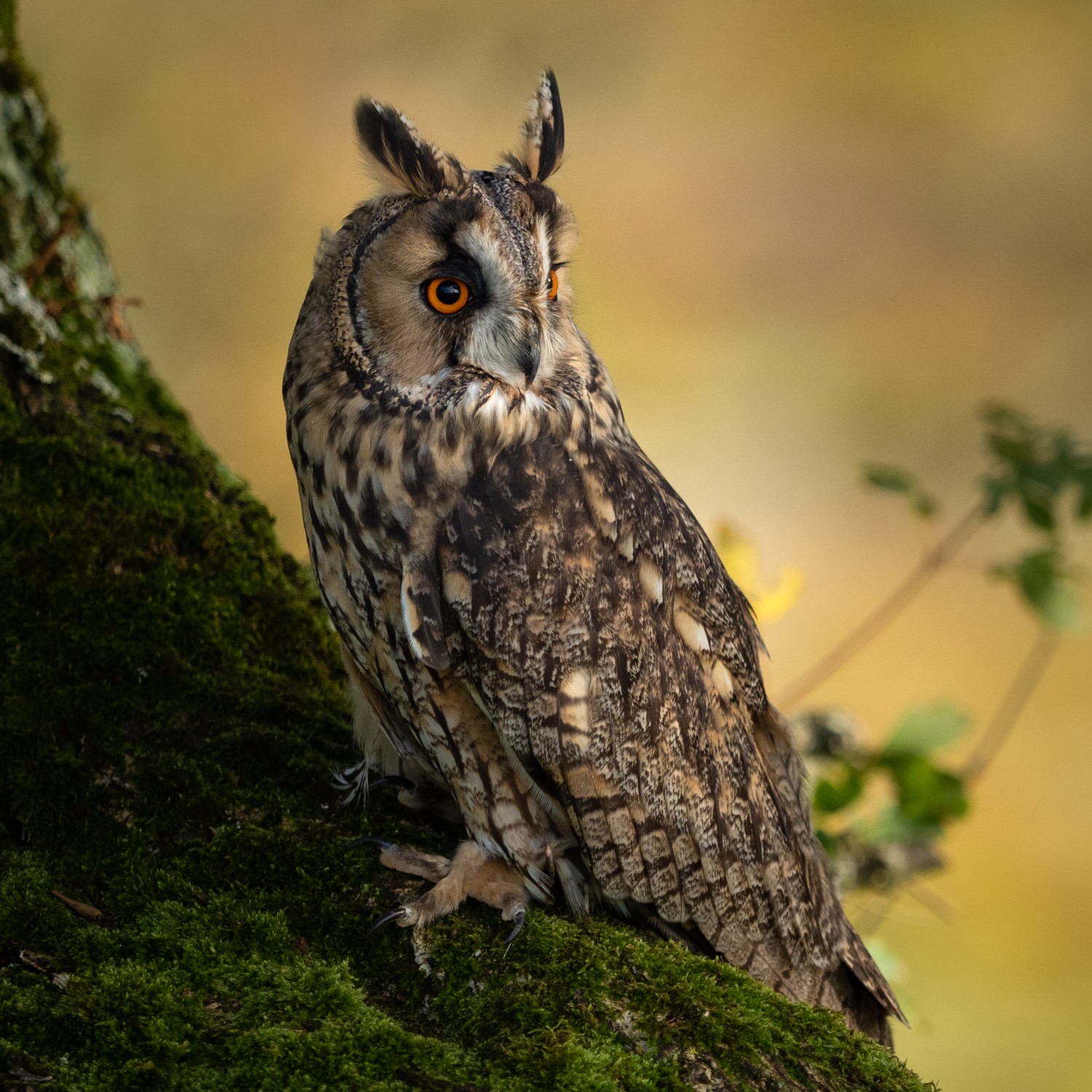
Long-Eared Owl
Asio otus
Order: Strigiformes
Family: Strigidae
Size: 14-16 in. (35-40 cm)
Overview
At 15 inches in length and with an impressive wingspan of 39 inches, the long-eared owl has been known to steal nests away from jays and crows to raise their own young. This somewhat elusive owl can be tough to find, preferring to seek shelter in dense woodlands. And, unfortunately, its population has declined 91% since 1970. Unlike most owls, long-eared owls are not very territorial and prefer to rely on their camouflage to hide from potential predators. When confronted, most long-eared owls simply fly away. Because these birds can be skittish, they can be tough for birdwatchers to track down. But if you are lucky enough to spot a long-eared owl, keep your eyes peeled for more — long-eared owls roost in groups of 6 to 50.
How to Identify
At first glance, the long-eared owl greatly resembles the great horned owl. But a closer inspection reveals that long-eared owls possess a distinctive V-shaped feather pattern on their faces. The tufts of feathers that make up their face disks surround bright orange eyes, giving them a surprised expression. The second set of feather tufts sitting on top of their heads gives them their iconic long-eared appearance These are lanky birds that have tan faces with variegated plumage in shades of brown, tan, gray, and white.
Long-Eared Owl Range & Migration Map
Long-eared owls live year-round in Wyoming, Nevada, Colorado, Arizona, New York, Michigan, and Wisconsin. During the breeding season, these birds venture farther north to Montana, North Dakota, and Minnesota. These birds can be spotted in all but the southernmost portion of Florida, Alabama, Mississippi, Louisiana, and Texas. Long-eared owls prefer to live in open spaces that have dense clusters of scattered trees, providing them with a safe place to seek shelter as they hunt for small mammals.
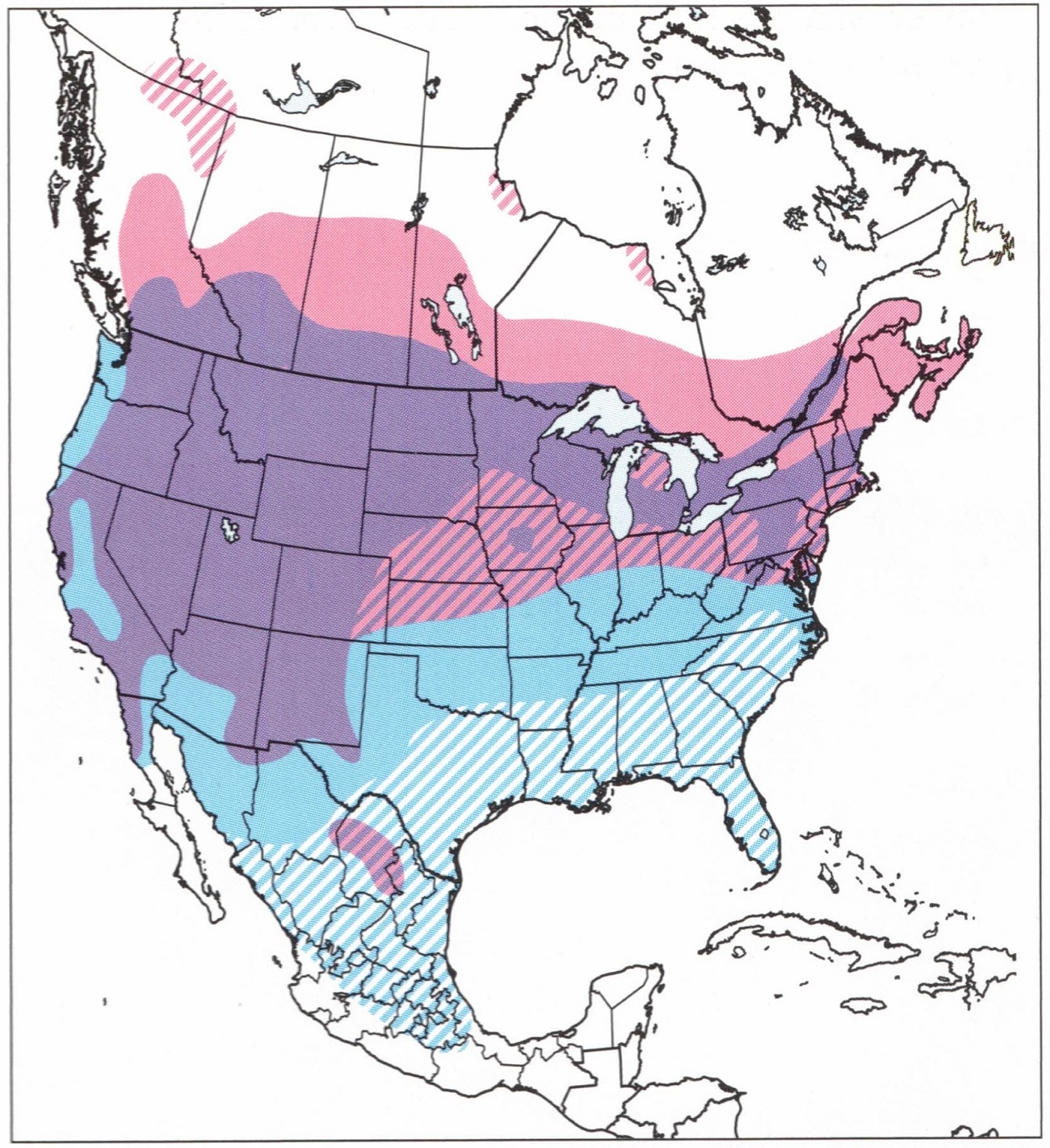
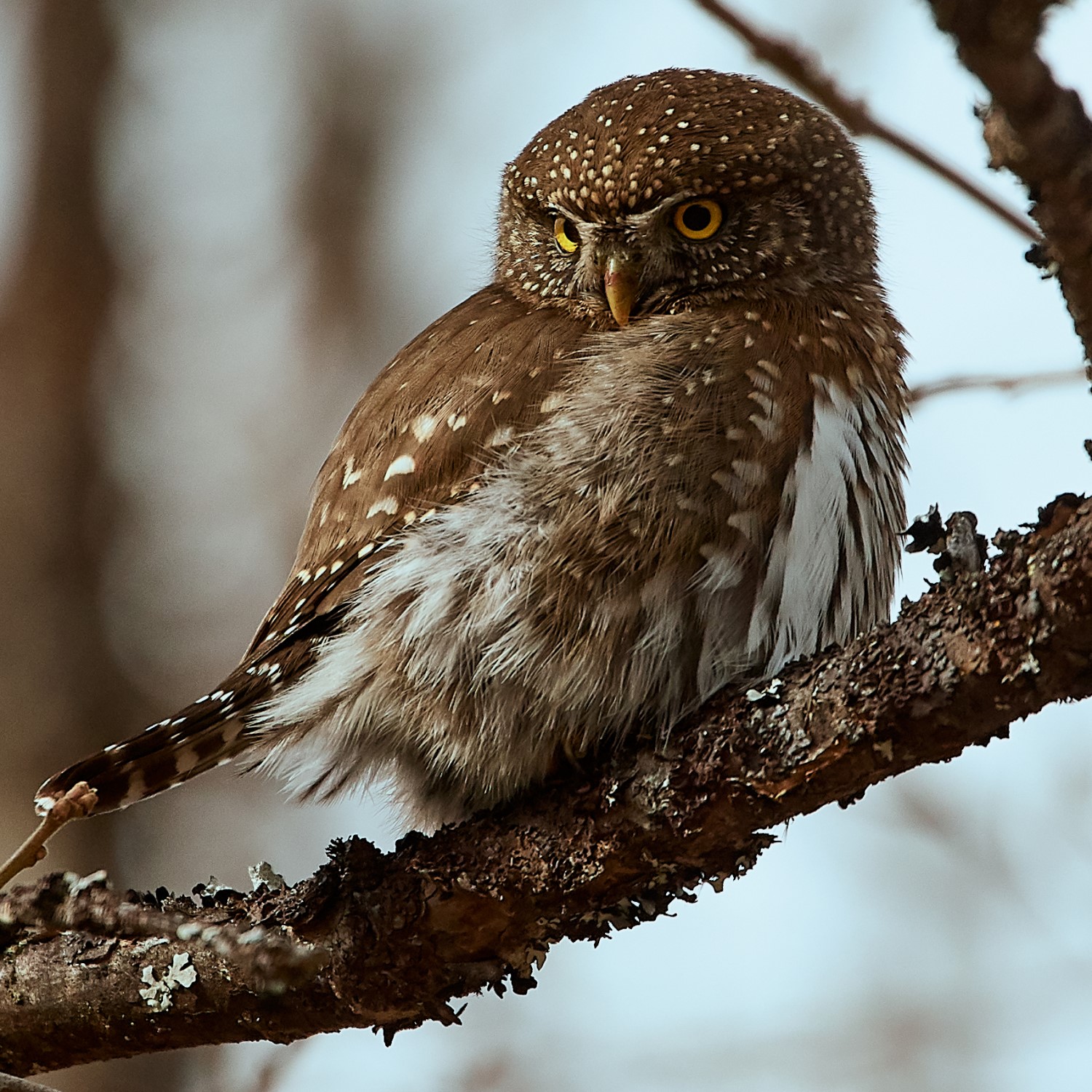
Northern Pygmy-Owl
Glaucidium gnoma
Order: Strigiformes
Family: Strigidae
Size: 6.5-7.3 in (16.5-18.5 cm)
Overview
These owls are a favorite among birdwatchers because they prefer to hunt during the daytime. This, coupled with their courageous nature, makes them easier to spot compared to more skittish members of the species. Northern pygmy owls are generally unafraid of humans, and will happily nest in urban areas. This is likely due to the fact that humans set up bird feeders to attract songbirds — the northern pygmy owl’s favorite food. These owls ambush their prey and store their leftovers on thorns and spikes to come back to later. Northern pygmy owls are such a threat to smaller birds that wrens, jays, and even hummingbirds will mob them to chase them away. Though these birds are only about as long as a butterknife, they’ve been known to attack prey much larger than themselves, including chickens. Because northern pygmy owls lack the substantive facial disks needed to improve hearing, they rely on their keen eyesight to track their prey.
How to Identify
At just 7 inches long, northern pygmy owls are quite small, but don’t let their size fool you. These are tough, tenacious little birds! Adults are gray, brown, or red-brown in color with white spotted heads and dark wings, tails, and breasts. Like ferruginous pygmy owls, northern pygmy owls have dark spots on the backs of their heads that look like another set of eyes. This helps to confuse both prey and predators. The best way to find a northern pygmy owl is to track its high-pitched tooting calls.
Northern Pygmy-Owl Range & Migration Map
These owls are somewhat adaptable, moving into cityscapes as their native mountain forests become less available. Unfortunately, however, these owls don’t often make their homes in nesting boxes, so these are an ineffective means of attracting them. You can find northern pygmy owls throughout the western states, in California, Oregon, and Idaho, and farther south in Colorado, Arizona, and New Mexico.
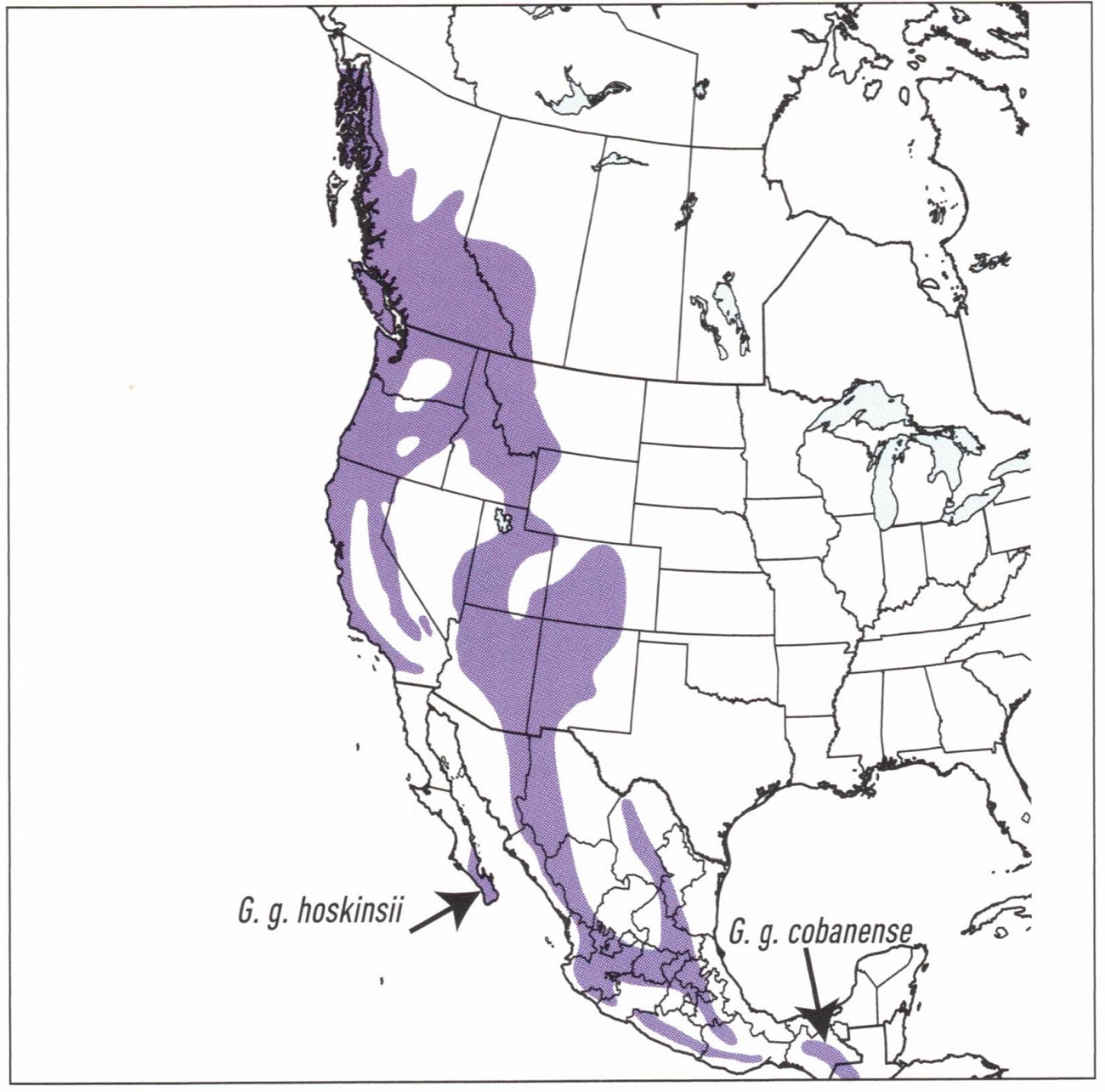
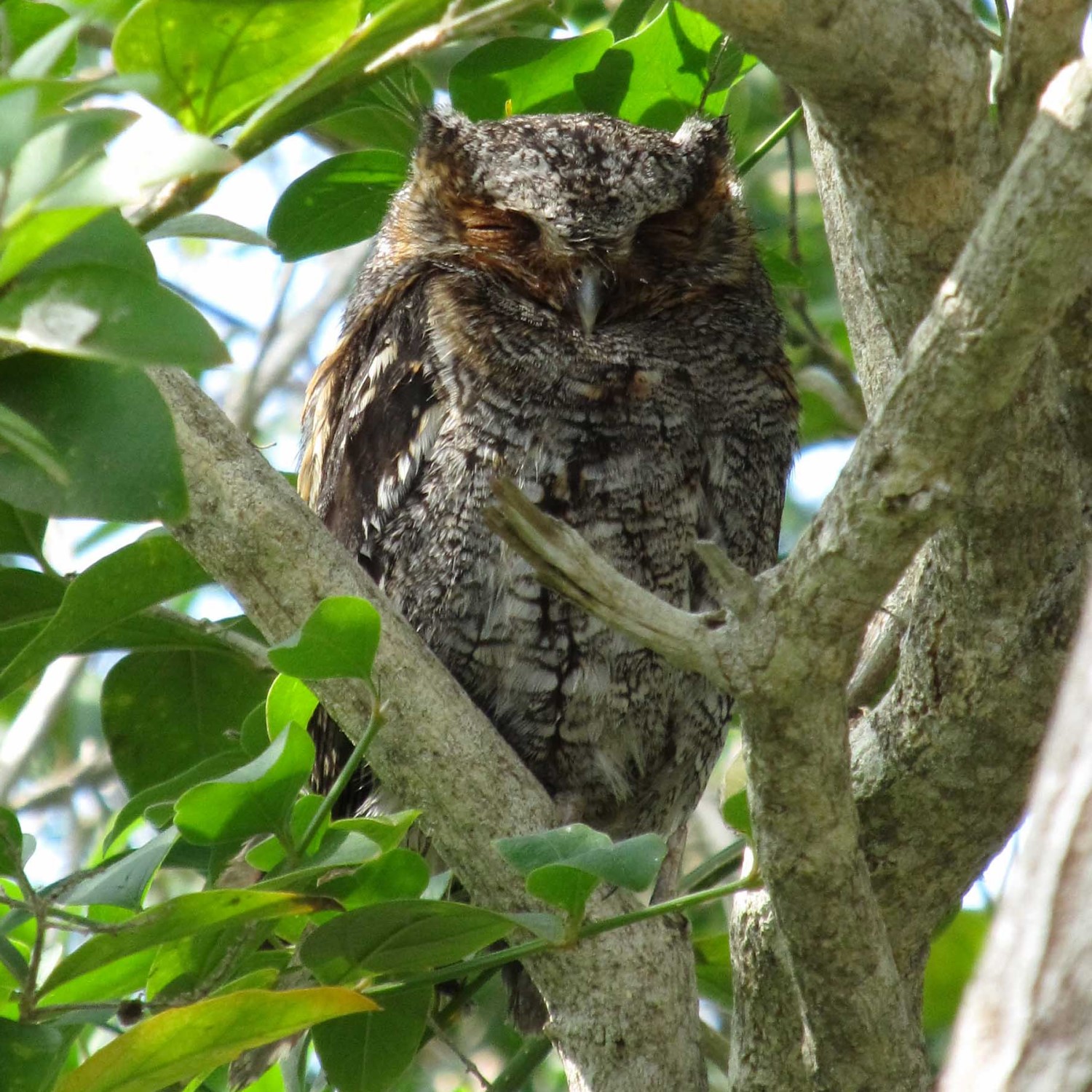
Flammulated Owl
Psiloscops flammeolus
Order: Strigiformes
Family: Strigidae
Size: 6-6.5 in. (15-17 cm)
Overview
Though these owls only measure around 6 inches in length, they have a large wingspan for their size, measuring 14-inches from wingtip to wingtip. Their long, powerful wings enable them to fly quickly between the treetops of their forest homes. These owls eat bugs almost exclusively, preferring moths and butterflies above other insects. In fact, this proclivity for insects may account for why these owls migrate south during the winter months. Flammulated owls are monogamous, choosing one mate for life. Mated pairs raise 2 to 4 owlets at a time in nests that are not lined with any sort of bedding material. Unlike most owls, who prefer to keep to themselves, flammulated owls form loose colonies — likely for protection since they’re so small.
How to Identify
Featuring feathers in shades of gray and brown with rust red tips along its wings, and distinctive flame-like markings on its face (hence its name), this owl is incredibly well-camouflaged. The best way to find a flammulated owl is by listening to its call. The flammulated owl has a much lower-pitch call than you would expect from such a small owl. This acts as a defense mechanism, tricking potential predators into thinking they’re much bigger than they really are.
Flammulated Owl Range & Migration Map
When it comes to tracking down flammulated owls, birdwatchers have their work cut out for them. Because these owls prefer to spend their time perched on the tops of tall conifers searching for bugs, they can be difficult to find. These birds migrate through west Texas and New Mexico and have a scattered breeding range that includes parts of California, Oregon, Washington, Idaho, Nevada, Utah, and Colorado, where they live from late April or early May to August.
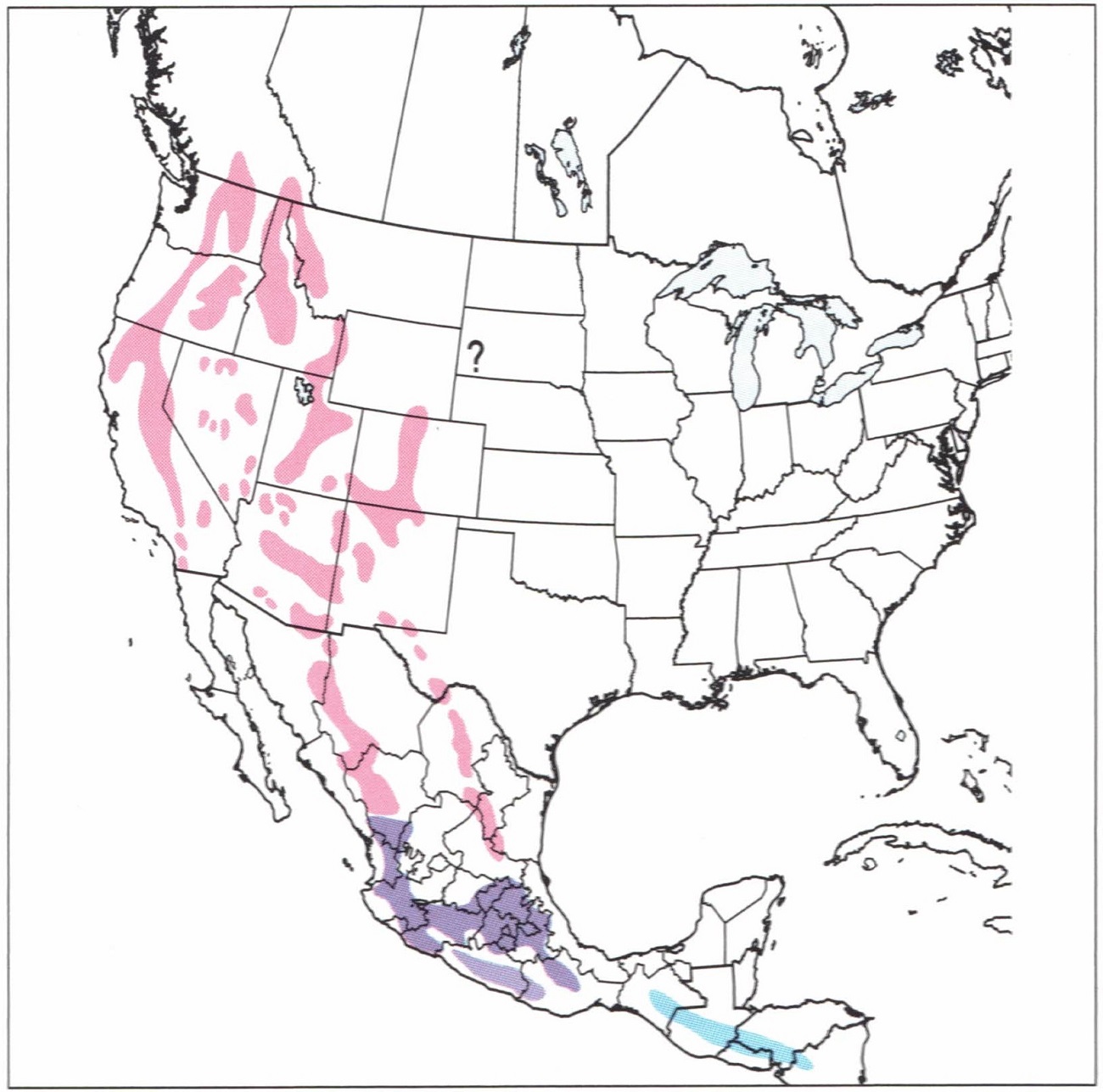
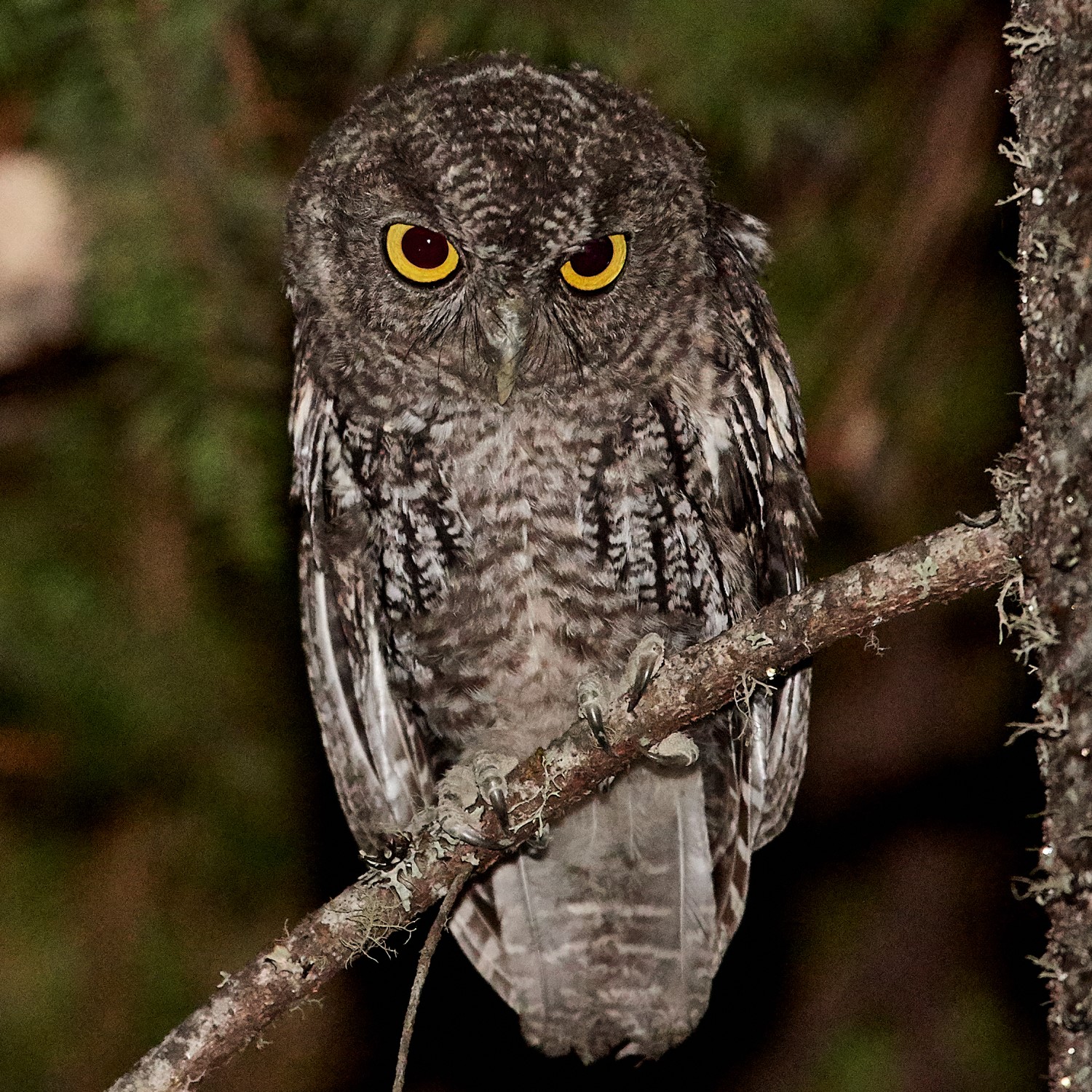
Western Screech-Owl
Megascops kennicottii
Order: Strigiformes
Family: Strigidae
Size: 7.5-9.5 in. (19-24 cm)
Overview
These are small owls, maxing out at just 9 inches in length and with wingspans of roughly 24 inches. But, don’t let their small stature deceive you. These birds are serious predators, regularly seeking out prey many times their own size. While western screech-owls feed on rodents, small birds, earthworms, and other bugs, they’ve also been seen preying on rabbits. Western screech-owls like to sit close to where limbs meet the tree trunk, so they can huddle up against them in order to camouflage themselves from predators and prey. These are opportunistic predators who like an easy meal, but, when determined, they will also chase their prey down, sometimes grabbing birds and insects midflight.
How to Identify
Western screech-owls look much like eastern screech-owls, with adult morphs in Great Plains, Mexican, Mojave, brown Pacific, and gray Pacific colorations. They have gray and brown plumage with no hint of red. Western screech-owls have small, round heads with ear tufts and vivid yellow eyes. Contrary to what their name would lead you to believe, western screech-owls usually don’t screech. Instead, they use short whistles and trills to communicate with each other.
Western Screech-Owl Range & Migration Map
These owls are highly adaptable, making their homes in a variety of regions, including deserts, grasslands, forests, and urban areas. You can find western screech-owls all across the west coast, drifting inward a bit to Idaho, Wyoming, Utah, Colorado, New Mexico, and parts of Texas. If you live in one of these regions, try installing a nesting box to attract a western screech-owl to your backyard.
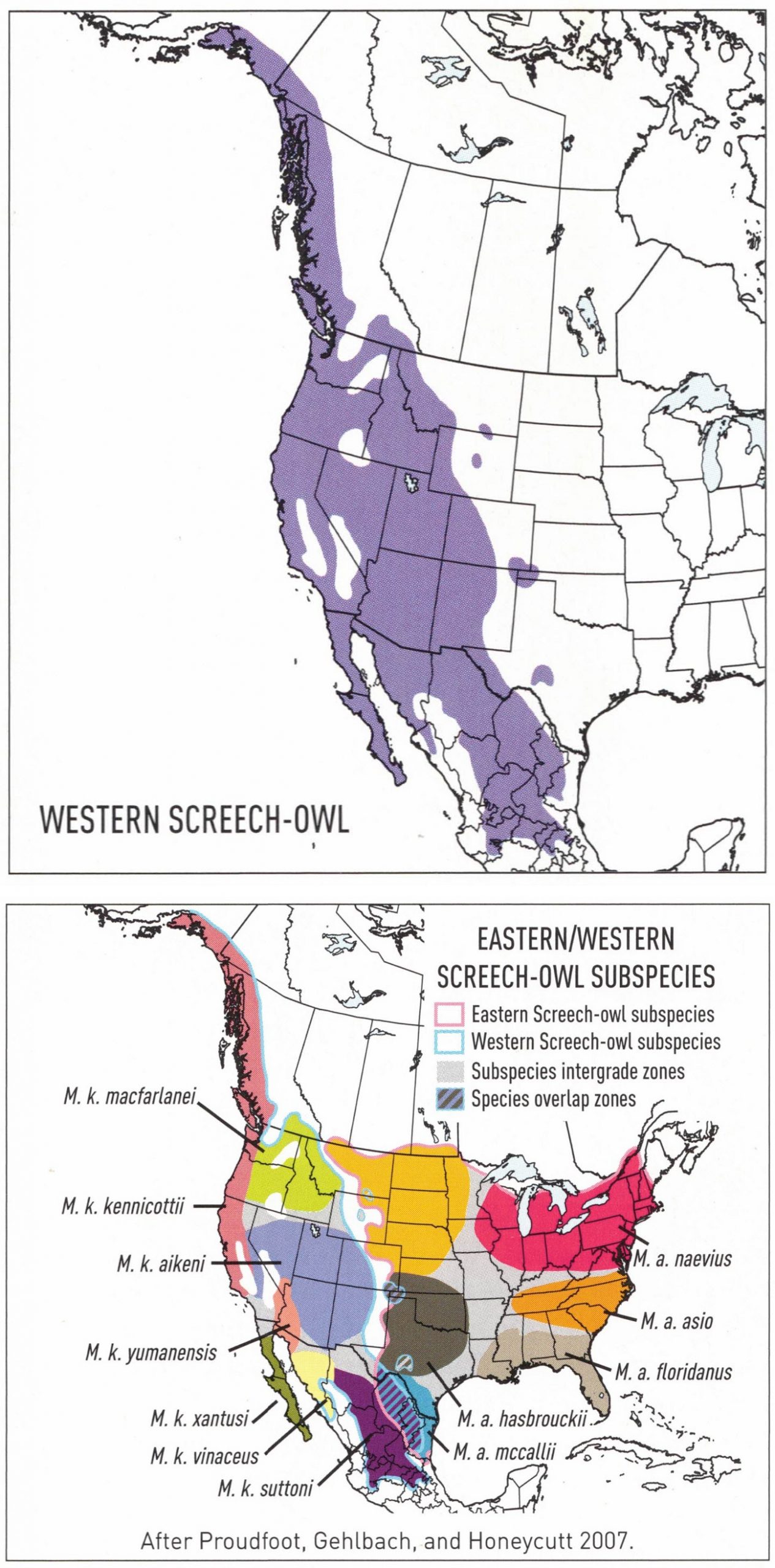

Barn Owl
Tyto alba
Order: Strigiformes
Family: Tytonidae
Size: 12.5-16 in. (32-40 cm)
Overview
Easily recognized by their pale heart-shaped faces, barn owls are some of the most widespread owls in the world. These owls thrive in deserts and grasslands, but can even be found in polar regions. Barn owls are especially common on farms, where they like to hunt for field mice among the crops in the morning and evening, and where they can take shelter in barns during the daytime. With their serrated wings, these fearsome predators fly noiselessly as they go in for the kill. Barn owls are monogamous, mating for life. They do not build nests but prefer to lay their eggs in the hollows of trees. The amount of food these birds receive has a direct impact on how many eggs they lay — the more voles, rats, and shrews they consume, the more owlets in their brood.
How to Identify
Barn owls are quite lanky compared to other owls. They have large hazel to brown eyes set in concave, heart-shaped faces that are surrounded by a delicate outline of pale brown feathers. Barn owls are milk white in color with tan and rust brown feathers on their backs and wings. These owls do not hoot but instead prefer to communicate via screeches.
Barn Owl Range & Migration Map
You can find the barn owl in all but the uppermost region of the U.S. Even though these birds are common throughout the nation, their population is dwindling somewhat due to habitation loss. Barn owls reside year-round as far south as Texas and Arizona, as far east as Pennsylvania, and all across the Pacific Northwest.
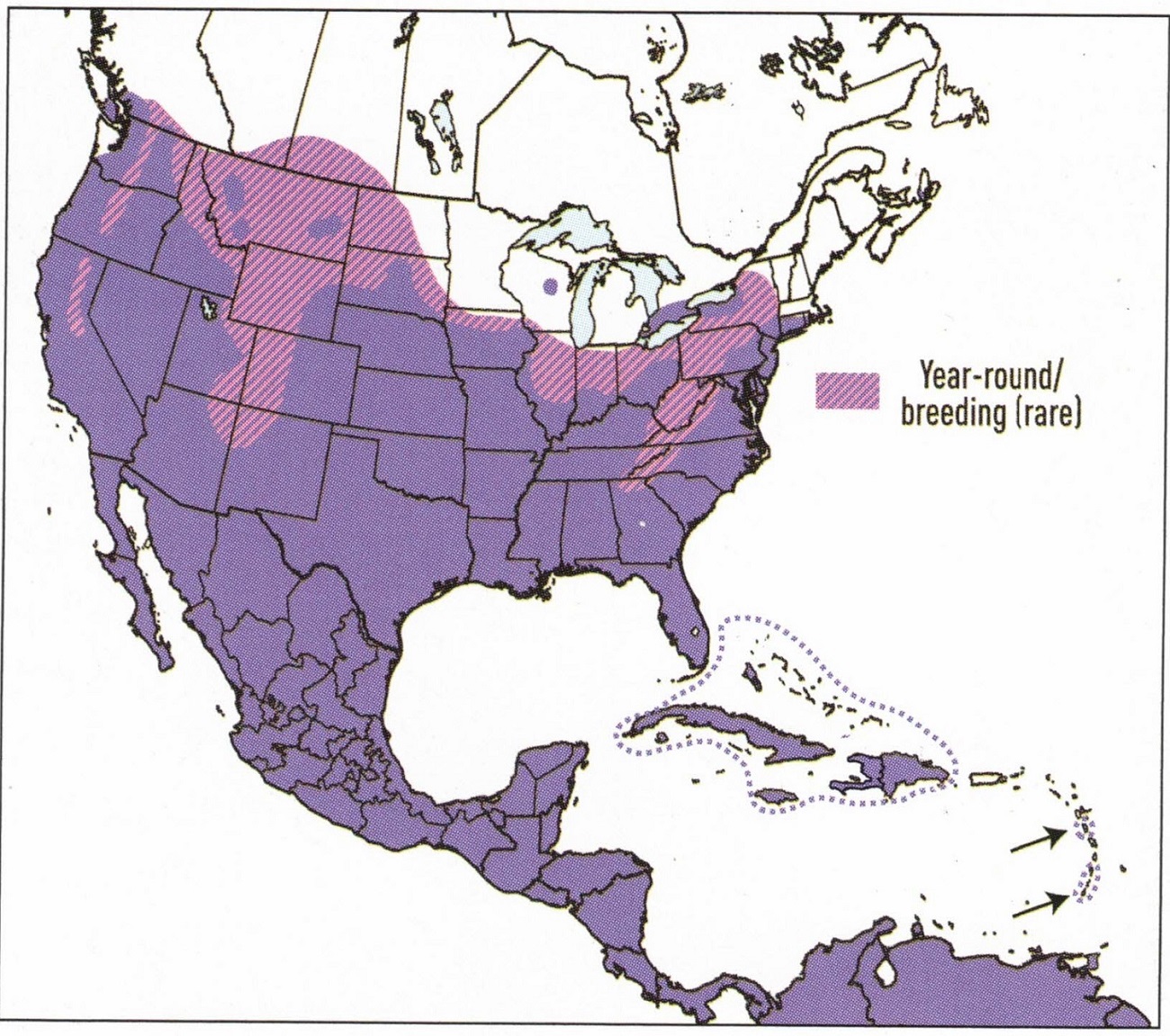

Great Horned Owl
Bubo virginianus
Order: Strigiformes
Family: Strigidae
Size: 18-26 in. (46-63 cm)
Overview
Far from meek, Great Horned owls have been known to hunt other birds of prey, including ospreys, peregrines, and even other owls. With their strong talons, these birds can exert 28-pounds of force allowing them to tackle larger prey. Great orned owls are a major threat to other birds, especially jays and crows. In fact, if you ever hear a large group of these birds making a fuss, there’s a good chance it’s because a great horned owl has gotten too close to their nests. The great horned owl’s plumage is ultra-soft, and this provides the animals with several benefits. For starters, it protects them from the harsh cold. But it also muffles sound, allowing them to fly silently as they swoop down on their prey. Interestingly, although the females of the species are larger than the males, females have higher-pitched voices, and mated pairs often synchronize their calls.
How to Identify
The great horned owl is easily identified by a matching pair of tufts on either side of its head, giving it a horned appearance. They have gray to red-brown barred plumage and golden yellow eyes that do not move within the sockets. These birds can rotate their heads 180 degrees to see and hear what’s going on around them. Facial feather discs help direct soundwaves to their ears, allowing them to track their prey, and their wide wings enable them to fly deftly, with serrated primary feathers dispersing turbulence and softer feathers muffling sound.
Great Horned Owl Range & Migration Map
These magnificent owls can be found in every state in the nation except Hawaii. These owls are native to the Americas, and they’re highly adaptable, dwelling in forested, rural, and urban areas alike. While you’re liable to see a great horned owl just about anywhere, keep your eyes peeled near wooded areas, especially along treelines as these birds like to perch near open fields to find their prey.
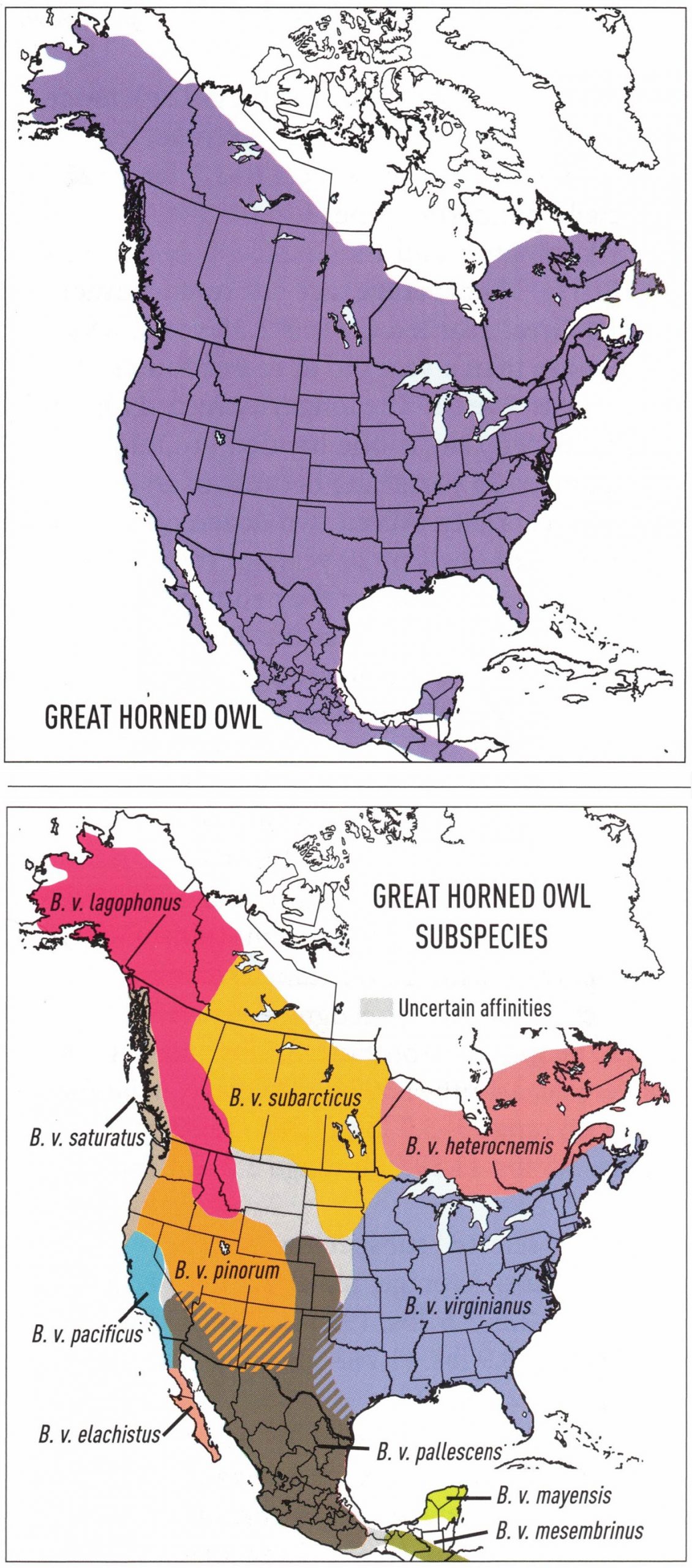
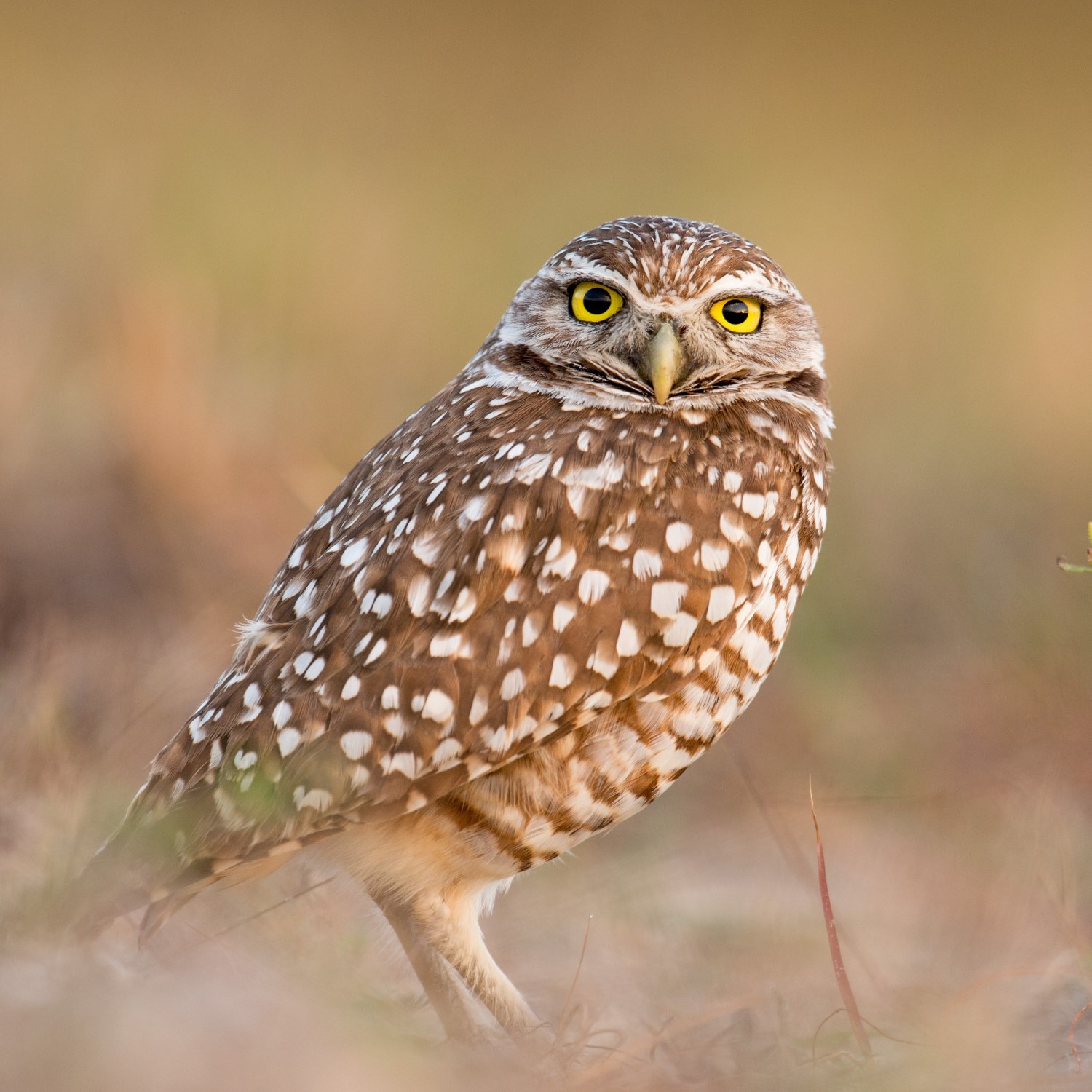
Burrowing Owl
Athene cunicularia
Order: Strigiformes
Family: Strigidae
Size: 7.5-9.8 in (19-25 cm)
Overview
These small owls live in grasslands and deserts where they enjoy feeding on insects, small mammals, and reptiles. Burrowing owls are among only a handful of owls that prefer to hunt during the daytime, spending their nights tucked away in their dens. When burrows are not available to them, these highly adaptable birds make their homes in buckets, pipes, and tubing. Burrowing owls have a higher tolerance for carbon dioxide than other birds, enabling them to spend more time huddled up in a small space. These birds cleverly use dung to carpet their dens, which invites insects to visit, providing the birds with an easy meal. Burrowing owls have also been known to hoard shiny objects, such as bottle caps, paper clips, and bits of tin foil.
How to Identify
Burrowing owls have long legs and an upright posture. They also have vivid yellow eyes and although their red-brown plumage resembles both the barred and boreal owls, the fact that they live on the ground makes it easy to differentiate between these species. Burrowing owls are pretty quiet, with males producing high-pitched “coo-coos” to defend their territories and attract mates.
Burrowing Owl Range & Migration Map
As their name suggests, burrowing owls make their homes in underground burrows, usually left behind by prairie dogs. You can find burrowing owls year-round throughout the southwest, predominantly in California, Arizona, New Mexico, and Texas. However, this owl’s breeding range extends much farther north, up to Washington, Montana, and North Dakota.
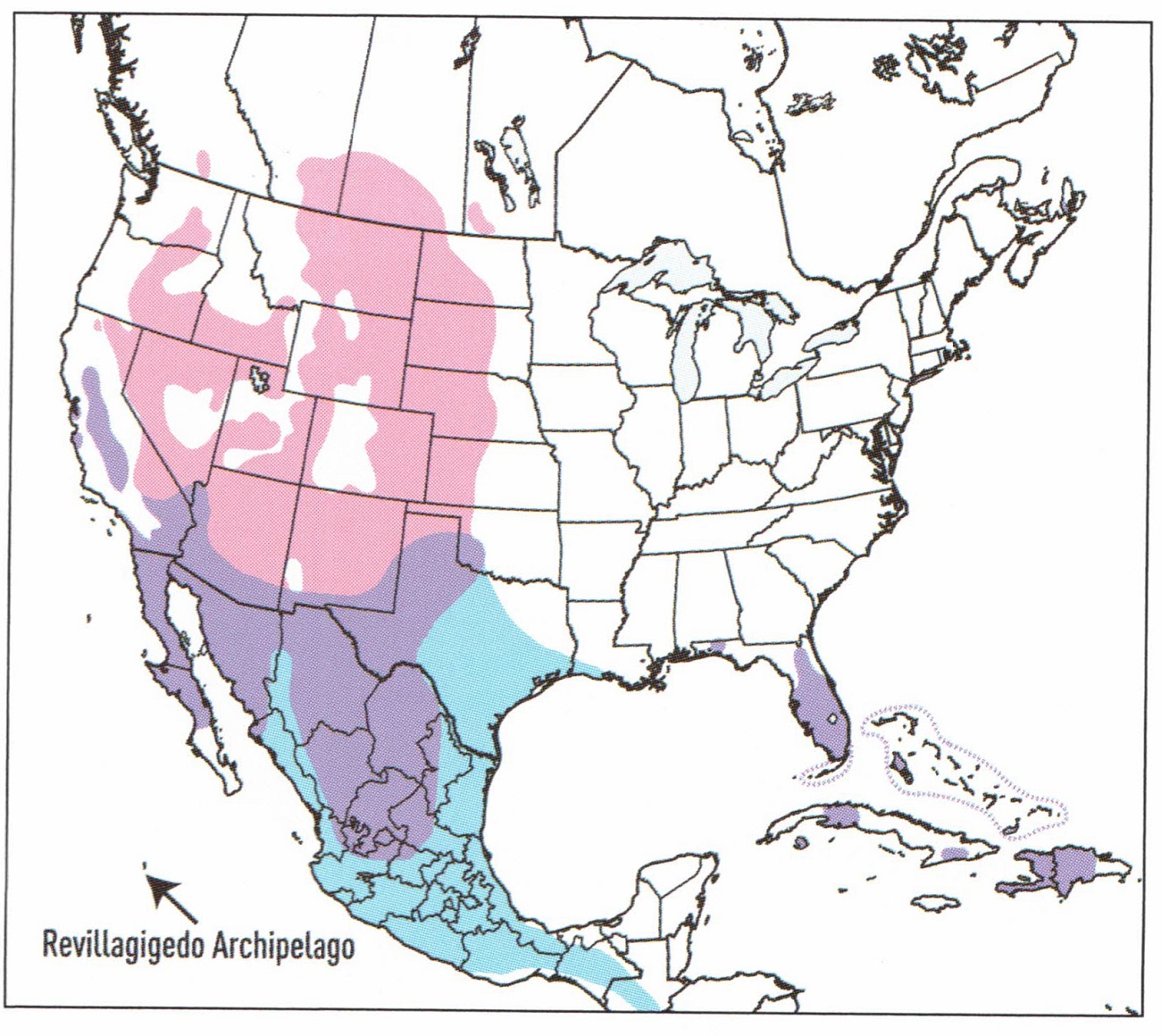
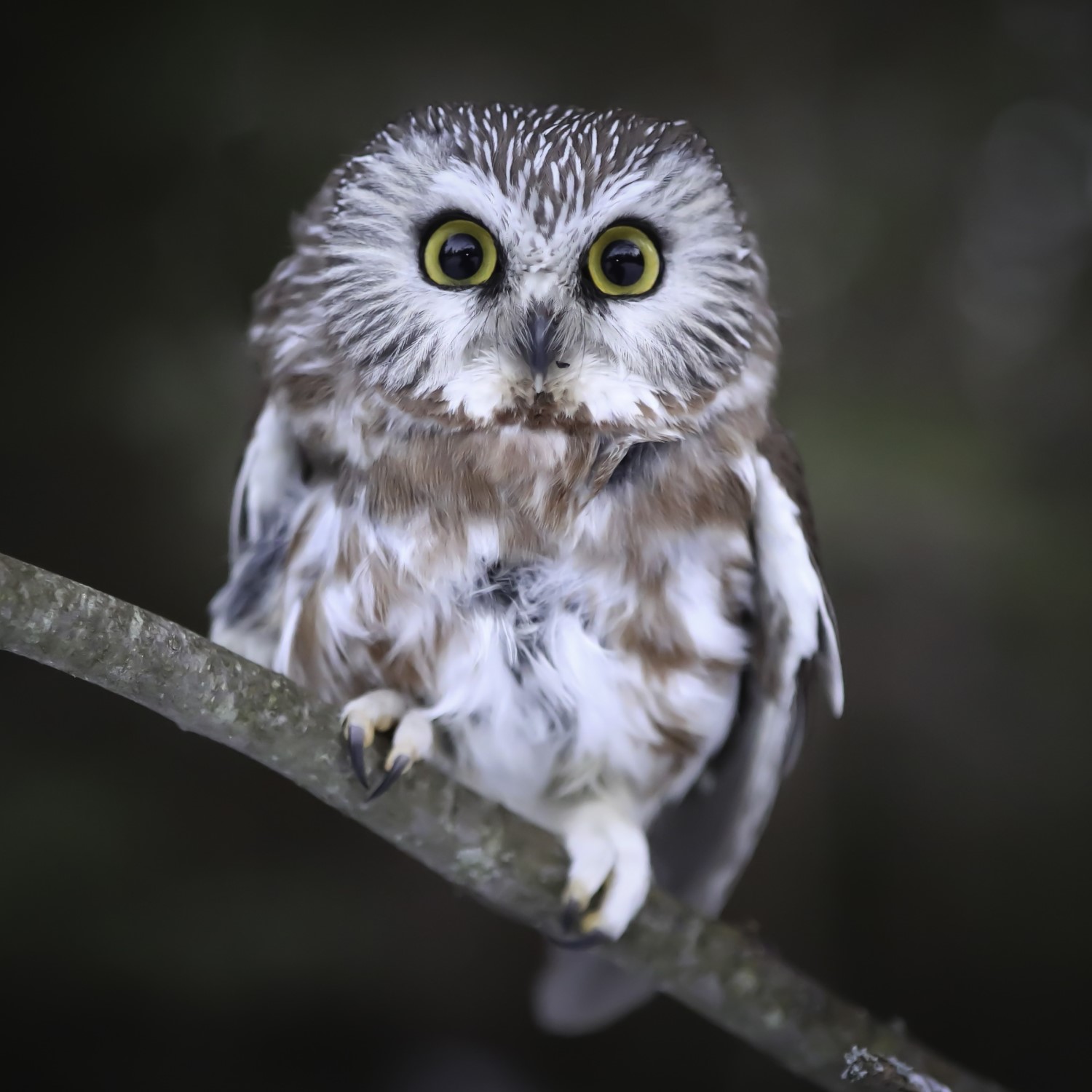
Northern Saw-whet Owl
Aegolius acadicus
Order: Strigiformes
Family: Strigidae
Size: 8-8.5 in. (20.3-21.5 cm)
Overview
These owls are short and compact. At just 8 inches in length and with a wingspan of 22 inches, northern saw-whet owls are among the smallest owls in the United States. Northern saw-whet owls like to prey on deer mice, using their sharp beaks to tear their prey into smaller pieces, breaking up a single mouse into several meals. Because these owls are nocturnal, and because they’re so small, they can be difficult to track. But their sharp cries make it easier to locate them in their forest homes. Northern saw-whet owls are mostly solitary creatures, only socializing with their mates. Females have been known to have two mates, leaving the first to raise a brood with the second. These owls have porphyrin pigments in their feathers, and when illuminated with a UV light, the ventral side of the wings shows a neon pink color. This helps researchers determine an owl’s age.
How to Identify
Named because its call sounds like a saw being sharpened on a whetstone, saw-whet owls have small heads and cat-like faces with relatively large yellow eyes. With rust-colored backs, breasts, and wings, northern saw-whet owls have spotted heads and distinctive Y-shaped markings on their faces. These owls use a variety of vocalizations to communicate. They’re most easily identified by their shrill “too-too-too” calls, which they use to attract mates. The cries of northern saw-whet owls are so loud that they can be heard nearly 1,000 feet away.
Northern Saw-whet Owl Range & Migration Map
One of the most common owls in the U.S., the northern saw-whet prefers to dwell in mountain forests. They can be found year-round in California, New Mexico, Utah, and Colorado, and in the northeastern states, Minnesota, Wisconsin, Michigan, New York, and all the way through to Maine. These owls can be seen in other territories, too, during non-breeding times. It’s not unheard of to see northern saw-whet owls throughout the midwest, including Kansas, Missouri, and Illinois.
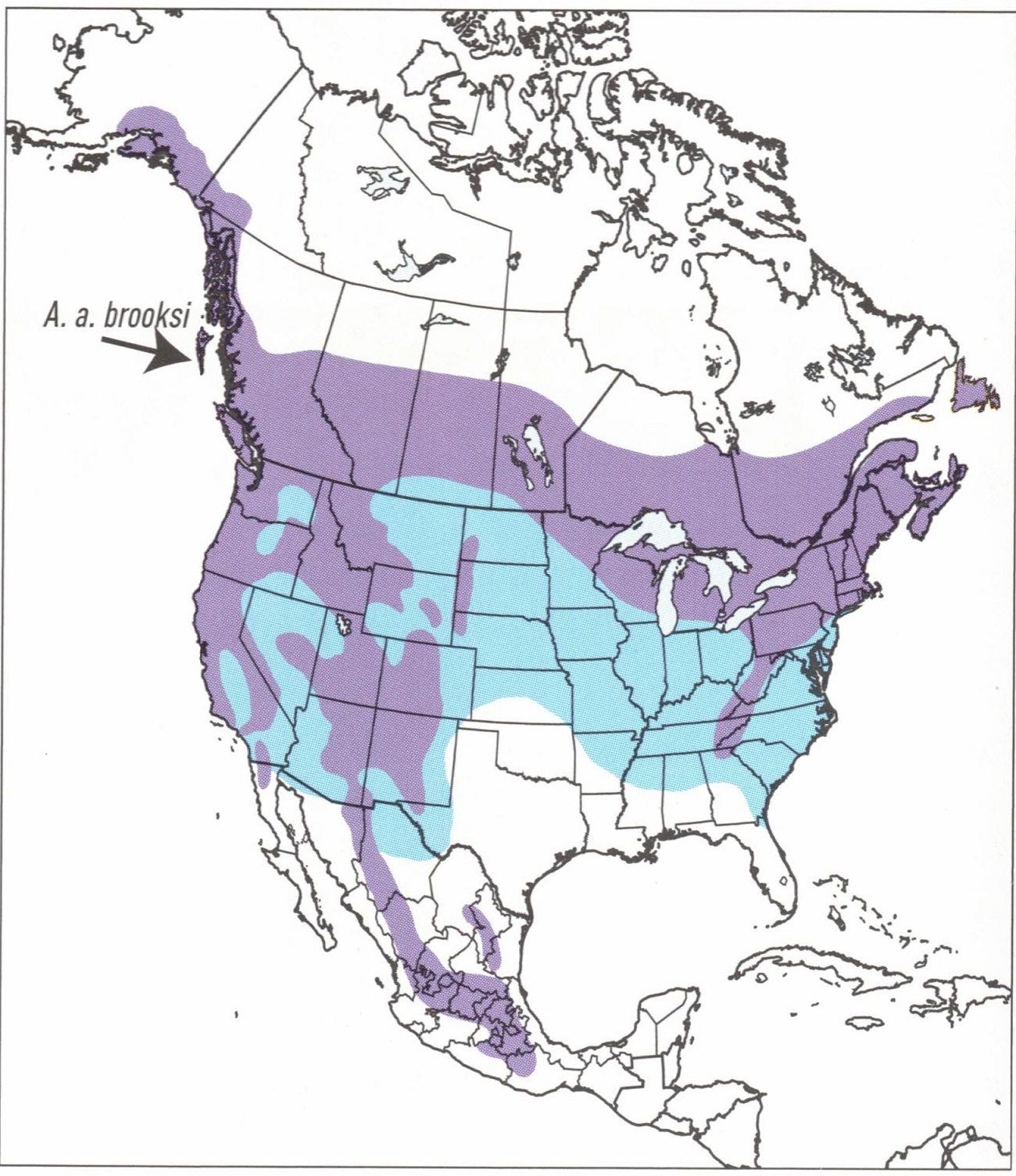
How to Attract Nevada Owls to Your Backyard
While some owls, like the boreal owl and the whiskered screech-owl, avoid humans and can be tough to find, other owls, like the barred owl and eastern and western screech-owls, are much easier to attract.
Install nesting boxes on trees, poles, and fences to encourage your neighborhood owls to take up residence on your property. Leaving brush, wood piles, and old lawn trimmings provides homes for voles, field mice, rabbits, gophers, and snakes. Having plenty of these critters nearby is a surefire way to get your local owls’ attention.
Because many owls like to feed on songbirds and squirrels, setting up a bird feeder and getting a bird bath can also encourage owls to pay you a visit. Of course, some birds work to scare owls off. Jays, crows, blackbirds, grackles, and starlings regularly mob owls, so take measures to scare these birds away — take down starling nesting boxes, and remove cracked corn and peanuts from your feeders, which are the preferred foods of these birds.
Owls love to sit on poles and in leafless trees because they make it easier for them to spot prey. Make sure your owls have plenty of spots to perch on. You can also attract these birds by limiting your outdoor activity, especially in the early morning and late evening hours when they like to hunt. Together, all of these measures will help your neighborhood owls feel right at home in your backyard.
All State Owls
Want to see what owl species are found in other states? Here’s our complete list of owls found in each state:
